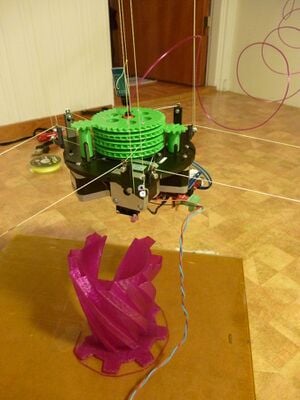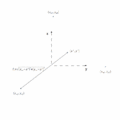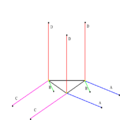No edit summary |
No edit summary |
||
| Line 24: | Line 24: | ||
!Price | !Price | ||
!Print volume | !Print volume | ||
|- | |||
| Big Rep | | Big Rep | ||
| ca $40,000<ref>http://www.fabbaloo.com/blog/2014/2/15/big-rep-one-is-one-big-rep</ref> | | ca $40,000<ref>http://www.fabbaloo.com/blog/2014/2/15/big-rep-one-is-one-big-rep</ref> | ||
| Line 29: | Line 30: | ||
|- | |- | ||
| Gigabot XL | | Gigabot XL | ||
| $13000<ref>http://shop.re3d.org/collections/gigabot-3d/products/gigabot-xl</ref> | | ca $13000<ref>http://shop.re3d.org/collections/gigabot-3d/products/gigabot-xl</ref> | ||
| 0.27 m^3 | | 0.27 m^3 | ||
|- | |- | ||
| X1000 | | X1000 | ||
| $16000<ref>http://www.3ders.org/articles/20140608-introducing-large-format-x1000-3d-printer.html</ref> | | ca $16000<ref>http://www.3ders.org/articles/20140608-introducing-large-format-x1000-3d-printer.html</ref> | ||
| 0.48 m^3 | | 0.48 m^3 | ||
|- | |- | ||
| Line 58: | Line 59: | ||
* When printer is idle, one could retract all the strings. Enables elegant storage solutions. Could make it popular in big cities, where indoor area is scarce. | * When printer is idle, one could retract all the strings. Enables elegant storage solutions. Could make it popular in big cities, where indoor area is scarce. | ||
<gallery caption="Sample gallery"> | <gallery caption="Sample gallery"> | ||
File: | File:Absolute_first_sketch.png|The first sketch of Hangprinters geometry. | ||
File: | File:Geometry_2d.gif|Straight lines are chopped into line segments by Clerck's firmware. This is the equation that Clerck's firmware needs to solve for each line segment. | ||
File: | File:Line_configuration.svg|Naming of Clerck's geometry's axes. Parallel lines prevents rotation. The black triangle is Clerck. The Black dots are called anchor points. The yellow dots are called action points. | ||
File:CAD_render_26_Nov.png|A render of Clerck's CAD file | |||
File:Cool-vinkel.jpg|A printed, mounted and assembled Clerck | |||
</gallery> | </gallery> | ||
== Costs == | == Costs == | ||
| Line 74: | Line 73: | ||
{| class="wikitable" | {| class="wikitable" | ||
|- | |- | ||
! | ! What | ||
! Qty | |||
! Total price | |||
|- | |||
| E3D V6 Valcano hot end | |||
| 1 | |||
| $150 | |||
|- | |||
| Nema17 stepper motor | |||
| 5 | |||
| $60 | |||
|- | |||
| Arduino Mega | |||
| 1 | |||
| $10 | |||
|- | |||
| RAMPS | |||
| 1 | |||
| $5 | |||
|- | |||
| drv8825 stepper driver | |||
| 5 | |||
| $10 | |||
|- | |||
| 623 bearing | |||
| 10 | |||
| $2 | |||
|- | |||
| 623 bearing v-groove | |||
| 5 | |||
| $5 | |||
|- | |||
| 608 bearing | |||
| 4 | |||
| $2 | |||
|- | |||
| JY-MCU Bluetooth Transceiver RF Module | |||
| 1 | |||
| $6 | |||
|- | |||
| 220V AC to 12V converter (power supply) | |||
| 1 | |||
| $16 | |||
|- | |||
| 2.7mm Eyes Inside Dia Fishing Rod Part | |||
| 9 | |||
| $9 | |||
|- | |||
| Hobbed drive gear | |||
| 1 | |||
| $2 | |||
|- | |- | ||
| | | Set of M3 screws, nuts and nyloc nuts | ||
| | | 1 | ||
| | | $5 | ||
|- | |- | ||
| | | Non-elastic fishing line (dynema) | ||
| | | 15 m | ||
| | | $1 | ||
|} | |} | ||
== Discussion == | == Discussion == | ||
Revision as of 02:13, 26 November 2015

Background
The RepRap project first showed the world cheap small scale 3D printing in 2006. Their design was intentionally not very well thought out. The idea was that a 3D printer that could print its own parts would be improved through evolution like iterations, no matter the quality of the first design. This turned out to be quite correct, as a large community quickly grew around the first few RepRap designs. RepRap users started to experiment and remix all parts of the printer, including its Cartesian coordinate system.
Understanding the market
Early non-Cartesian 3D printer designs were the Tripod-Repstrap[1](2007) and its geometrically similar successors Rostock (2012)[2] and Lisa Simpson (2013)[3][4]. Other non-carthesian RepRap designs include GUS Simpson (2013)[5], Morgan (2013)[6], Wally (2013)[7] and Feather (2013)[8].
All these printers tries to trade heavier geometrical computations for getting rid of hardware requirements or time consuming build steps. They all have frames, and there's still spare clock cycles left in their Arduino CPUs. The idea of Clerck is to skip the hard custom frame altogether and instead rely on wire-connections to already-built rigid structures, like insides of houses.
Making this work would lead to potentially enormous print volumes for prices down to ca $400. Competitors prices are:
| Name | Price | Print volume |
|---|---|---|
| Big Rep | ca $40,000[9] | 1 m^3 |
| Gigabot XL | ca $13000[10] | 0.27 m^3 |
| X1000 | ca $16000[11] | 0.48 m^3 |
Other large scale experimental printers include the Wasp's Big Delta Printer[12] and the KamerMaker, a scaled up Cartesian design[13].
The presented competitors are very expensive and not very self reproducing, many of them are not even free design hardware. They don't satisfy the needs of for example the Open Source Ecology project, who wants to print structural plastic components like car body panels and redworm towers with OSHW tools.
Project goals
- Low part count
- Easy to print, assemble, install and distribute
- Huge build volume
- Cheap
- Able to print many of its own parts
Design
- Put all the hardware (except AC/DC-converter) in one single unit.
- Only one force vector upwards, compensated with counter weight.
- Over-constraining allows flexible compensation of slack lines.
- When printer is idle, one could retract all the strings. Enables elegant storage solutions. Could make it popular in big cities, where indoor area is scarce.
- Sample gallery
-
The first sketch of Hangprinters geometry.
-
Straight lines are chopped into line segments by Clerck's firmware. This is the equation that Clerck's firmware needs to solve for each line segment.
-
Naming of Clerck's geometry's axes. Parallel lines prevents rotation. The black triangle is Clerck. The Black dots are called anchor points. The yellow dots are called action points.
-
A render of Clerck's CAD file
-
A printed, mounted and assembled Clerck
Costs
You may describe your costs here.
| What | Qty | Total price |
|---|---|---|
| E3D V6 Valcano hot end | 1 | $150 |
| Nema17 stepper motor | 5 | $60 |
| Arduino Mega | 1 | $10 |
| RAMPS | 1 | $5 |
| drv8825 stepper driver | 5 | $10 |
| 623 bearing | 10 | $2 |
| 623 bearing v-groove | 5 | $5 |
| 608 bearing | 4 | $2 |
| JY-MCU Bluetooth Transceiver RF Module | 1 | $6 |
| 220V AC to 12V converter (power supply) | 1 | $16 |
| 2.7mm Eyes Inside Dia Fishing Rod Part | 9 | $9 |
| Hobbed drive gear | 1 | $2 |
| Set of M3 screws, nuts and nyloc nuts | 1 | $5 |
| Non-elastic fishing line (dynema) | 15 m | $1 |
Discussion
Your discussion.
Next steps
The next steps.
Conclusions
Your conclusions.
References
- ↑ http://builders.reprap.org/search/label/tripod
- ↑ http://reprap.org/wiki/Rostock
- ↑ http://reprap.org/wiki/LISA_Simpson
- ↑ http://forums.reprap.org/read.php?178,267835
- ↑ http://reprap.org/wiki/GUS_Simpson
- ↑ http://reprap.org/wiki/RepRap_Morgan
- ↑ http://reprap.org/wiki/Wally
- ↑ http://forums.reprap.org/read.php?1,214837,214859
- ↑ http://www.fabbaloo.com/blog/2014/2/15/big-rep-one-is-one-big-rep
- ↑ http://shop.re3d.org/collections/gigabot-3d/products/gigabot-xl
- ↑ http://www.3ders.org/articles/20140608-introducing-large-format-x1000-3d-printer.html
- ↑ http://www.3ders.org/articles/20150914-wasp-big-delta-3d-printer-has-potential-to-build-insect-repelling-houses.html
- ↑ http://3dprintcanalhouse.com/
Contact details
Add your contact information.




